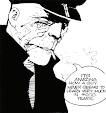 As a structure buff, I was chuffed when I saw the NT was going to be producing JB Priestley's Time and the Conways. Along with Pinter's Betrayal, it's often cited as an interesting use of non-linear narrative - something that's much less common on the stage than the screen.
As a structure buff, I was chuffed when I saw the NT was going to be producing JB Priestley's Time and the Conways. Along with Pinter's Betrayal, it's often cited as an interesting use of non-linear narrative - something that's much less common on the stage than the screen.Priestley was fascinated by the nature of time, and explored it in his 'time plays', including Time and the Conways, I Have Been Here Before and An Inspector Calls.
Time and the Conways borrows the notion that all time exists simultaneously in different dimensions. So, if we were fully aware, we could experience the past and the future as well as the present.
The play's structure is deceptively simple. In Act I, we're introduced to the wealthy and privileged Conway family in 1919, on the 21st birthday of daughter and budding novelist Kay. With the horrors of the Great War behind them, they look forward optimistically to the future.
Then, in Act II, we jump forward 19 years to 1938, and Kay's 40th birthday. Instead of another party, there's a bitter summit about the family's ruined fortunes. We also see how the siblings' high hopes for themselves - and the world in general - have turned to dust.
Act III returns to the night of Kay's 21st, and shows how the family themselves sowed the seeds of their later misfortune. This is a classic example of a powerful narrative tool: dramatic irony, when the audience knows more than the characters about their situation, and can see the full significance of their words and actions.
In film terms, Hitchcock spoke about dramatic irony as a means of cranking up audience involvement and suspense, using the example of two people sitting at a table who don't realise there's a bomb underneath it. If the audience doesn't know either, the film will just produce one moment of surprise - when the bomb goes off.
However, if the audience does know that the device is ticking away, "the same innocuous conversation becomes fascinating because the public is participating in the scene. The audience is longing to warn the characters on the screen: ‘You shouldn’t be talking about such trivial matters. There is a bomb beneath you and it is about to explode!’"
Anyway, back at the National... The production itself doesn't really take off until the beginning of Act II. During the first act it's hard to distinguish between the various Conway sisters amid the golly-gosh-lashings-of-ginger-beer squeaky poshness.
When the cast return 19 years later though, wearing the heavy disappointment of time, the acting steps up a gear and each of them becomes totally distinct. So, when we return to 1919, we suddenly see through the frothy exteriors to the people they're set to become.
Given the play's naturalistic tone, one slight problem was director Rupert Goold's insistence on ending each act with a showy and distracting bit of stage business. The lurch into video projection and physical theatre at the end of Act III was a particular distraction, dissipating the effect of Priestley's ending and leaving some of the audience a bit baffled. If it ain't on the page, it shouldn't always be on the stage.
Video preview/interviews (The Guardian)


No comments:
Post a Comment